Tom's Hardware Verdict
The Ryzen 9 7950X and Ryzen 5 7600X bring the Zen 4 architecture and new connectivity, like PCIe 5.0 and DDR5. The Ryzen 9 7950X slots in as the overall performance champ for PCs, while the Ryzen 5 7600X is unquestionably the fastest gaming chip on the market for $300.
Pros
- +
Class-leading single- and multi-thread
- +
Higher boost frequencies
- +
Reasonable price-per-core
- +
Overclockable
- +
DDR5 and PCIe Gen 4.0
- +
iGPU
Cons
- -
Pricing
- -
Requires beefy cooling
- -
No bundled cooler
- -
DDR5 only
- -
Requires AM5 motherboard
Why you can trust Tom's Hardware
AMD’s flagship 16-core $699 Ryzen 9 7950X and entry-level six-core $299 Ryzen 5 7600X are the bookend models in the new Ryzen 7000 “Raphael” lineup, and they take leading spots on our list of Best CPUs and our CPU Benchmark hierarchy with Intel-beating performance in nearly every category, including gaming and applications.
Intel’s hybrid Alder Lake processors caught AMD flatfooted, taking the lead in both performance and value at every price point. The Ryzen 7000 processors fire back with the new Zen 4 architecture, which AMD claims increases IPC by 13%, etched on the TSMC 5nm process. That combo delivers incredible peak clocks of 5.7 GHz — an increase of 800 MHz that marks a record for AMD’s Ryzen family. It’s also surprisingly a higher clock speed than we see with even Intel’s fastest chips, at least until the company’s 6 GHz Raptor Lake chips come to market.
| Row 0 - Cell 0 | Price | Cores / Threads (P+E) | Base / Boost Clock (GHz) | Cache (L2+L3) | TDP / Max | Memory |
| Ryzen 9 7950X | $699 | 16 / 32 | 4.5 / 5.7 | 80MB | 170W / 230W | DDR5-5200 |
| Ryzen 9 7900X | $549 | 12 / 24 | 4.7 / 5.6 | 76MB | 170W / 230W | DDR5-5200 |
| Ryzen 7 7700X | $399 | 8 / 16 | 4.5 / 5.4 | 40MB | 105W / 142W | DDR5-5200 |
| Ryzen 5 7600X | $299 | 6 / 12 | 4.7 / 5.3 | 38MB | 105W / 142W | DDR5-5200 |
Paired with vastly improved power delivery, which comes courtesy of a new platform, AMD’s process and architecture advances deliver truly explosive performance gains. AMD’s new chips drop into the new AM5 socket, which the company has committed to supporting until 2025, on 600-series motherboards. In addition, the new platform comes replete with support for the latest interfaces, like DDR5 and PCIe 5.0, largely matching Intel’s connectivity options. AMD has even developed its own EXPO DDR5 memory profiles for overclocking, rivaling Intel’s XMP standard. The Ryzen 7000 chips also come loaded with other new tech, like a new Radeon RDNA 2 iGPU for basic display output and support for AVX-512 and AI instructions.
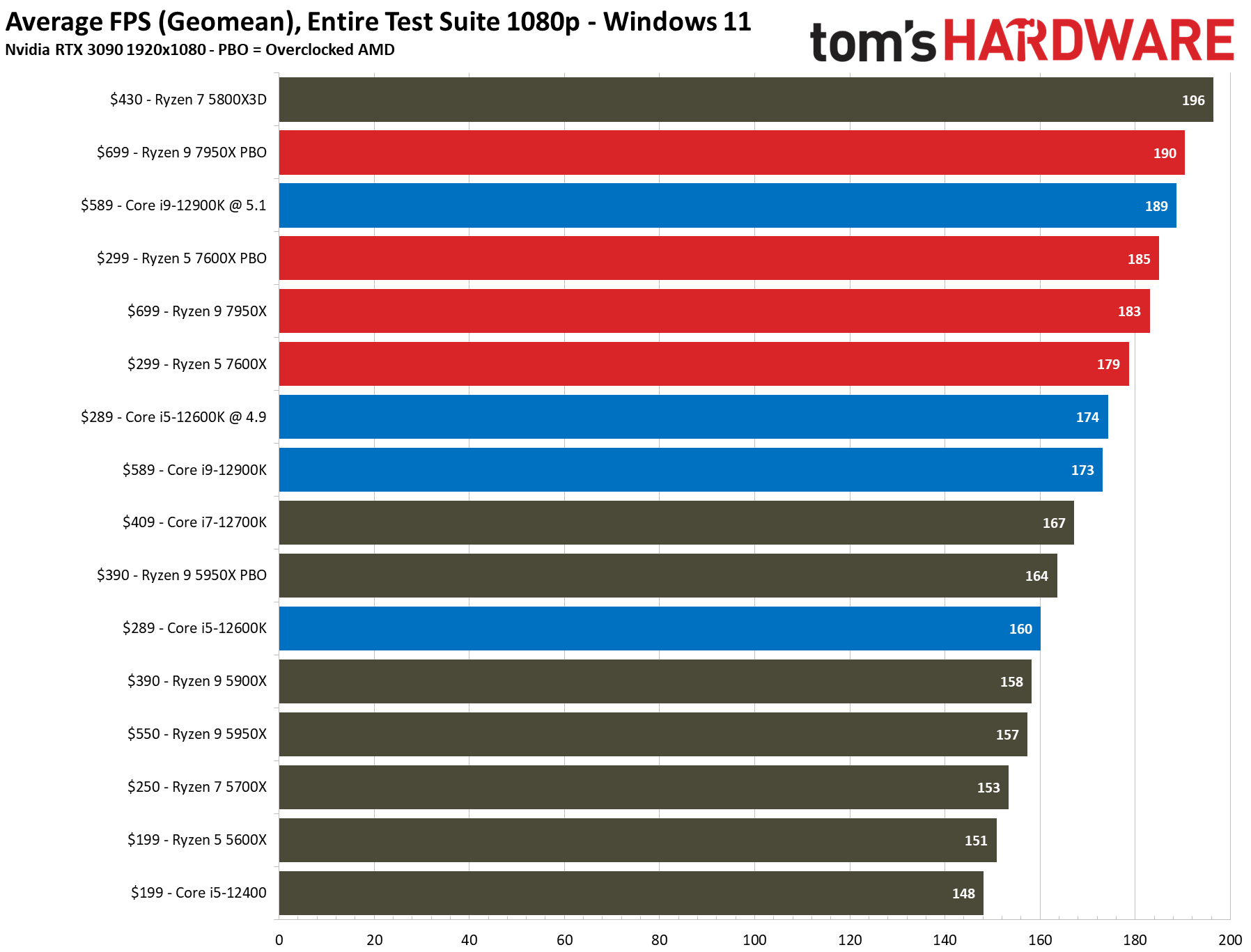

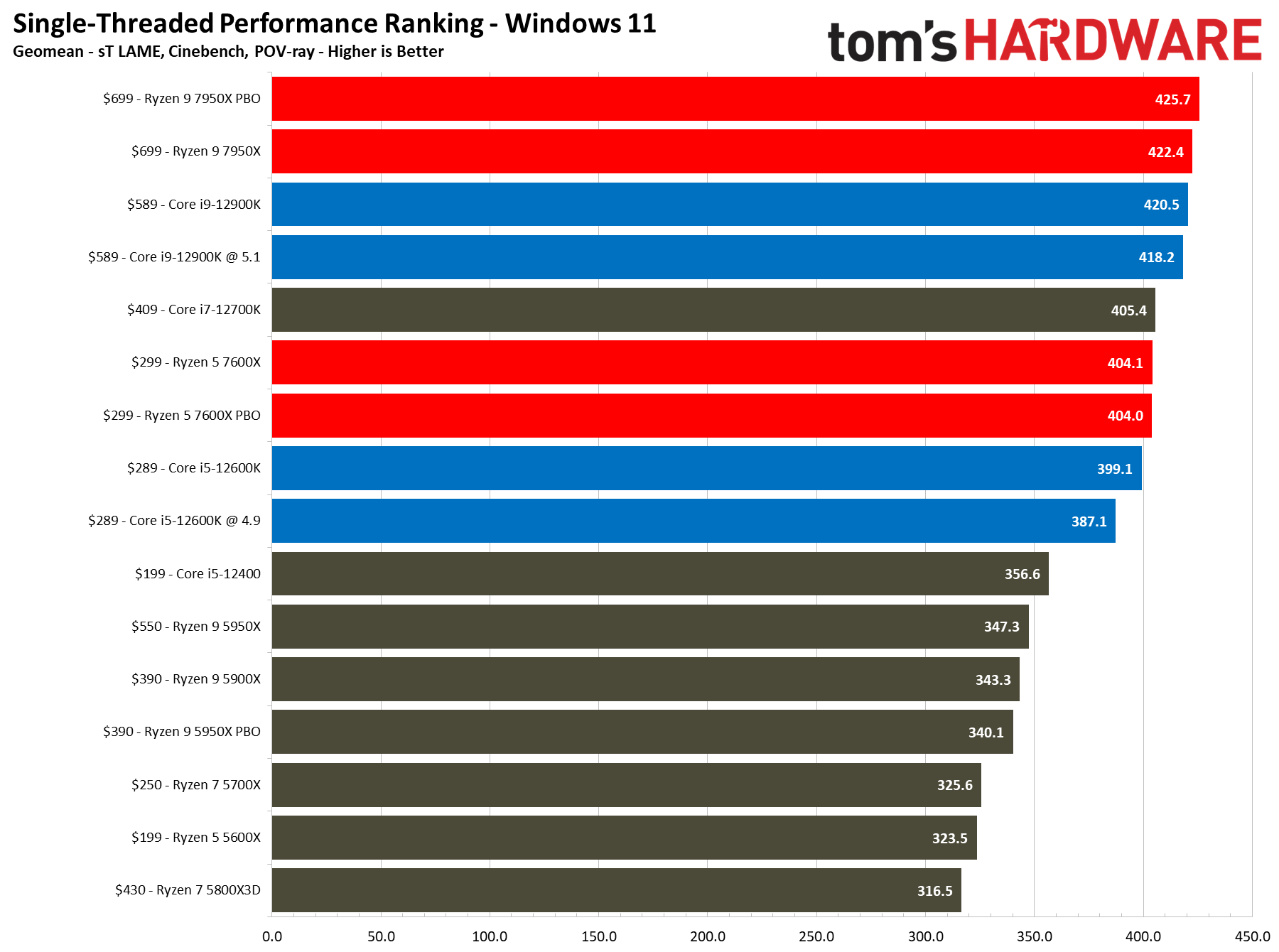
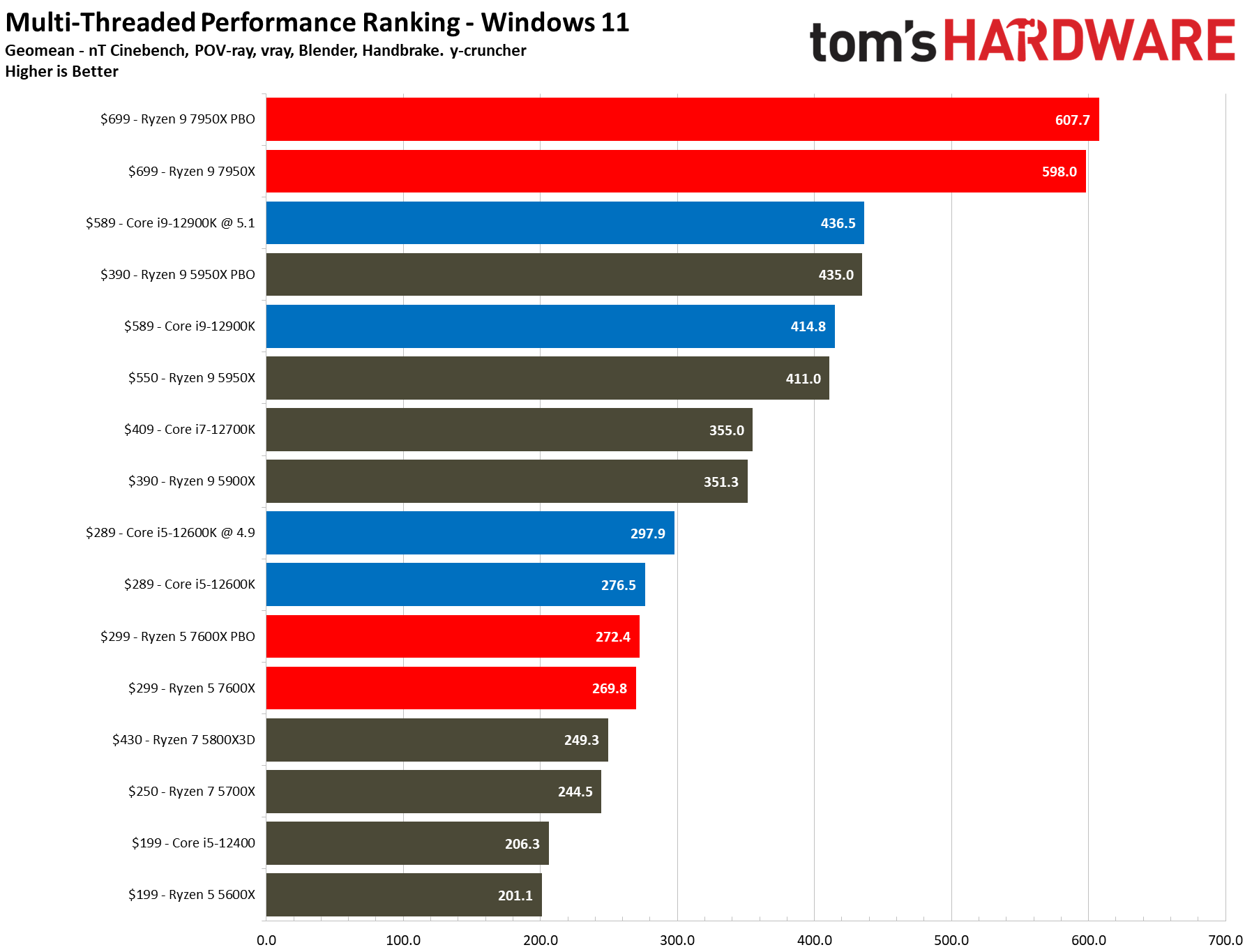
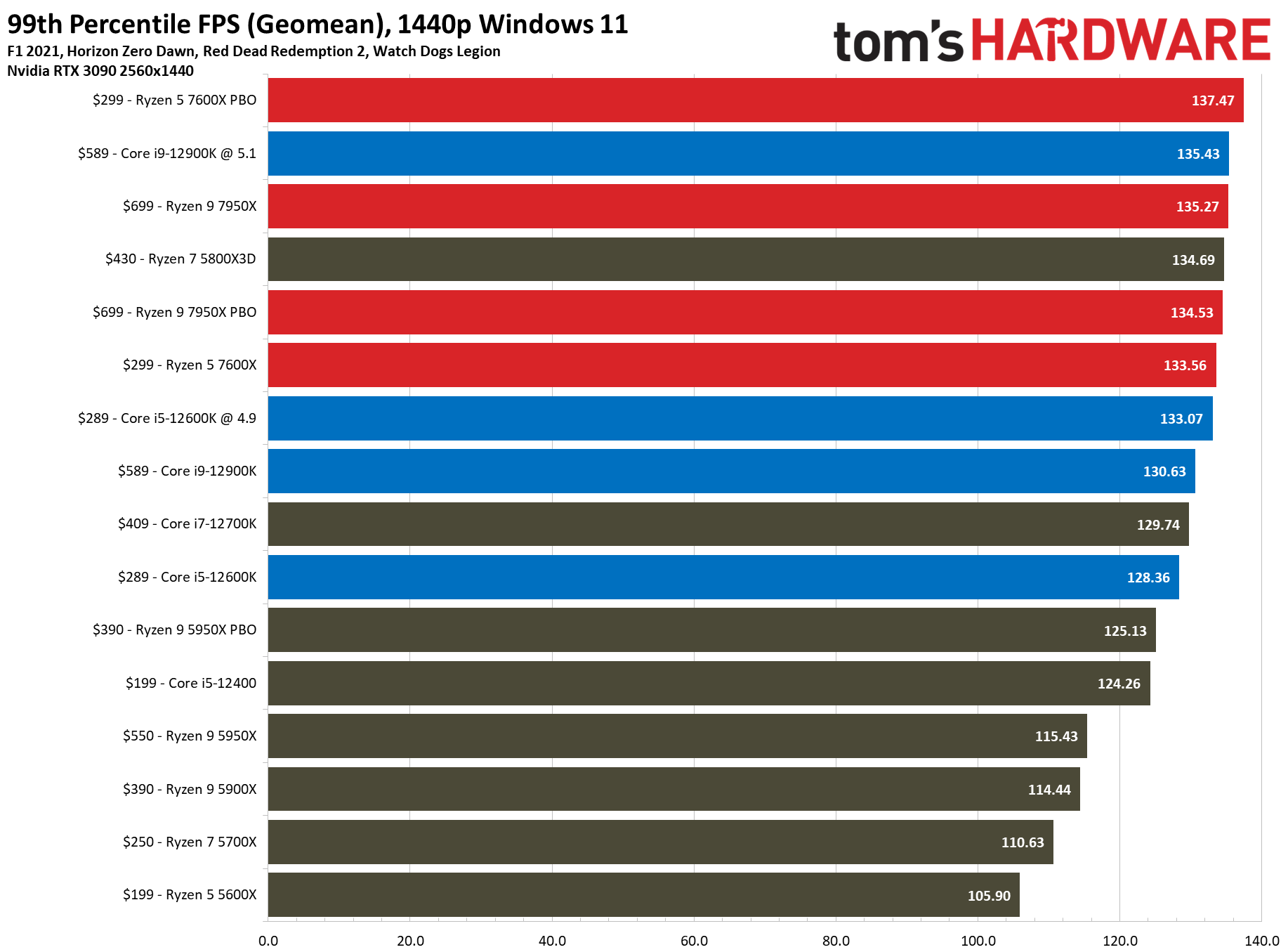
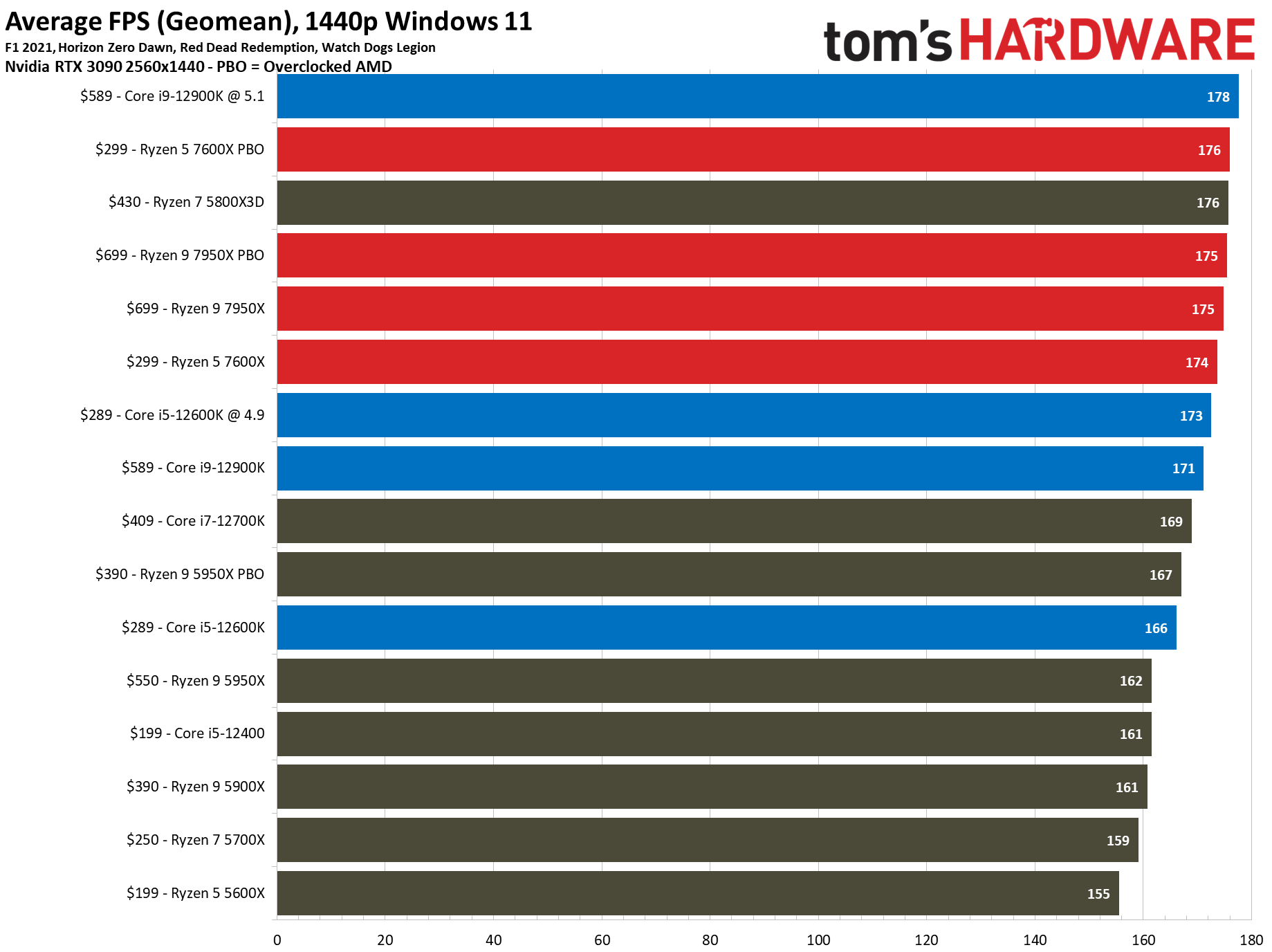
As a quick preview of our extensive tests on the following pages, the flagship Ryzen 9 7950X makes incredible gains — it’s up to 15% faster at gaming, 21% faster in single-threaded work, and 45% faster in threaded work than its predecessor, setting a new bar for the highest-end mainstream chips. In fact, the $3,299 Threadripper Pro 5975WX is only 17% faster than the 7950X in threaded work, but it costs almost six times more. That’s not to mention that the 7950X beats the Core i9-12900K across the board.
The Ryzen 5 7600X is equally impressive, delivering up to 18% faster gaming performance than its predecessor in tandem with 25% and 34% gains in single- and multi-threaded work, respectively, ushering in a new unmatched level of performance at the $300 price point.
Both chips beat Intel’s flagship in gaming. However, as impressive as they are, they aren’t perfect: The Zen 4 Ryzen 7000 series has a high $300 entry-level price point and only supports pricey DDR5 memory instead of including less-expensive DDR4 options like Intel. That muddies the value proposition due to the expensive overall platform costs. AMD also dialed up power consumption drastically to boost performance, inevitably resulting in more heat and a more power-hungry system. You do end up with more performance-per-watt, though.
Ryzen 7000 takes the lead in convincing fashion, but its real competitor, Raptor Lake, doesn’t come until next month. Nevertheless, Intel claims its own impressive performance gains of 15% faster single-threaded, 41% faster threaded, and a 40% ‘overall’ performance gain, meaning we’ll see a close battle for desktop PC leadership. In the meantime, here’s how the current chips stack up. (Be sure to check out our full boost, thermals, power, and IPC testing, too.)
Ryzen 9 7950X and Ryzen 5 7600X Specifications and Pricing
As a reminder, the Ryzen 7000 processors come with the N5 TSMC 5nm process node for the core compute die (CCD) and the TSMC 6nm process for the I/O Die (IOD). You can see learn about this design in our Zen 4 Ryzen 7000 all we know article.
Get Tom's Hardware's best news and in-depth reviews, straight to your inbox.
| Row 0 - Cell 0 | Price | Cores / Threads (P+E) | Base / Boost Clock (GHz) | Cache (L2/L3) | TDP / PBP / MTP | Memory |
| Ryzen 9 7950X | $699 | 16 / 32 | 4.5 / 5.7 | 80MB (16+64) | 170W / 230W | DDR5-5200 |
| Ryzen 9 5950X | $546 ($799 debut) | 16 / 32 | 3.4 / 4.9 | 74MB (8+64) | 105W | DDR4-3200 |
| Core i9-13900K / KF | ? | 24 / 32 (8+16) | 3.0 / 5.8 | 64MB (32+36) | 125W / 253W | DDR4-3200 / DDR5-5600 |
| Core i9-12900K / KF | $589 (K) - $564 (KF) | 16 / 24 (8+8) | 3.2 / 5.2 | 44MB (14+30) | 125W / 241W | DDR4-3200 / DDR5-4800 |
| Ryzen 9 7900X | $549 | 12 / 24 | 4.7 / 5.6 | 76MB (12+64) | 170W / 230W | DDR5-5200 |
| Ryzen 7 7700X | $399 | 8 / 16 | 4.5 / 5.4 | 40MB (8+32) | 105W / 142W | DDR5-5200 |
| Ryzen 5 7600X | $299 | 6 / 12 | 4.7 / 5.3 | 38MB (6+32) | 105W / 142W | DDR5-5200 |
| Ryzen 7 5600X | $199 ($299 debut) | 6 / 12 | 3.7 / 4.6 | 35MB (3+32) | 65W | DDR4-3200 |
| Core i5-13600K / KF | ? | 14 / 20 (6+8) | 3.5 / 5.1 | 44MB (20+24) | 125W / 181W | DDR4-3200 / DDR5-5600 |
| Core i5-12600K / KF | $289 (K) - $264 (KF) | 10 / 16 (6+4) | 3.7 / 4.9 | 29.5MB (9.5+20) | 125W / 150W | DDR4-3200 / DDR5-4800 |
This is how Ryzen 7000 stacks up against Intel’s existing Alder Lake chips, along with information we’ve collected about Intel’s yet-to-be-fully-announced Raptor Lake. Be aware that the Raptor Lake specifications in the above table are not yet official.
The 16-core 32-thread Ryzen 9 7950X is $100 less than the original launch pricing of the Ryzen 9 5950X. AMD also kept the entry-level pricing at the same $299 with the Ryzen 5 7600X, which is a high bar for entry to the Ryzen 7000 family. Conversely, Intel has said it will increase its chip pricing due to economic factors, so we’ll have to wait to see its official pricing to judge the 7600X’s positioning.
AMD didn’t increase core counts with the Ryzen 7000 family — instead, it focused on architectural and process node enhancements that deliver more performance per core. The company also worked on improving its power delivery to unleash more performance, which we’ll dive into a bit later.
The $699 16-core Ryzen 9 7950X comes with a 4.5 GHz base and 5.7 GHz boost, with the latter being the highest boost frequency of the four initial Ryzen 7000 processors. The chip comes with 16 MB of L2 cache, a doubling over the prior-gen models, and 64MB of L3 cache. This chip has a 170W TDP rating and a max power draw of 230W, the highest power consumption of any Ryzen chip yet. The 7950X vies with Intel’s Core i9-12900K for now, but it will eventually face the Core i9-13900K that will come with eight additional efficiency cores for a total of 24 cores.
The $399 6-core Ryzen 5 7600X has a 4.7 GHz base and 5.3 GHz boost clock. This chip has 6MB of L2 cache, double that of its predecessor, and 32MB of L3. The Ryzen 5 7600X has a 125W TDP rating and a peak power draw of 181W, marking a new high for Ryzen 5. The 7600X will compete with the Core i5-12600K for now, but the Core i9-13600K should arrive next month with an additional four e-cores, for a total of 14 cores. We also have a review of the 12-core, 24-thread Ryzen 9 7900X here.
The Raphael processors drop into a new AM5 socket that supports the PCIe 5.0 and DDR5 interfaces, matching Alder Lake on the connectivity front. The Socket AM5 motherboards can expose up to 24 lanes of PCIe 5.0 to the user.
Ryzen 7000 supports DDR5-5200 if you install one DIMM per channel (1DPC), but that drops to DDR5-3600 for 2DPC. AMD also introduced its own new memory overclocking spec to compete with Intel’s XMP. The new EXPO profiles are very similar to the existing XMP profiles we're accustomed to. Still, they are designed specifically for AMD processors, allowing one-click memory overclocking to predefined speeds. AMD has partnered with the major memory vendors to create EXPO kits, and the company expects 15 or more to be available at launch with speeds reaching up to DDR5-6400. As before, AMD also supports ECC memory by default, but implementation is up to the motherboard vendor.
The Ryzen 9 7950X and Ryzen 5 7600X don’t come with bundled coolers. Instead, AMD recommends a 240-280mm liquid cooler or equivalent for Ryzen 9 processors. Meanwhile, you’ll need a mid-frame tower cooler (or equivalent) for the Ryzen 7 and 5 models. You should expect loaded temperatures to regularly reach 90C to 95C, which is within spec and won’t damage the chip.
| Year / Processor | Peak Frequency | Frequency Gain | Process, Architecture |
| 2017 - Ryzen 7 1800X | 4.1 GHz | - | 14nm Zen 1 |
| 2018 - Ryzen 7 2700X | 4.3 GHz | +200 MHz / +5% | 12nm Zen+ |
| 2019 - Ryzen 9 3950X | 4.7 GHz | +400 MHz / +9% | 7nm Zen 2 |
| 2020 - Ryzen 9 5950X | 4.9 GHz | +200 MHz / +4% | 7nm Zen 3 |
| 2022 - Ryzen 9 7950X | 5.7 GHz | +800 MHz / +16% | 5nm Zen 4 |
Here we can see AMD’s progression in clock rates over the Ryzen era. As you can see, the 800 MHz increase in clock speeds with the 7000 series processors marks the largest single gain in Ryzen’s history. For now, AMD has the highest official clock speed on the market, but Intel says that Raptor Lake will have a peak 6 GHz clock rate. That will likely arrive on a pricey KS special edition model, but Intel hasn’t said when it would come to market.
This generation of chips finds the chipmakers again embroiled in a frequency war, with both chipmakers pushing their consumer chips to the highest clocks we've seen with their modern offerings. That also brings higher power consumption, so we also see higher TDP figures from both chipmakers as they increase frequencies.
Naturally, we have to view the increased power consumption through the prism of how much performance-per-watt the processor provides. Here, AMD has made big strides courtesy of the architecture and process node enhancements. We’ll provide more detail in the power consumption section.
- MORE: Best CPUs for Gaming
- MORE: CPU Benchmark Hierarchy
- MORE: AMD vs Intel
- MORE: Raptor Lake All We Know
Current page: Into the Zen 4 Era
Next Page iGPU Benchmarks and AM5 Motherboards, Ryzen 9 7950X and Ryzen 5 7600X
Paul Alcorn is the Editor-in-Chief for Tom's Hardware US. He also writes news and reviews on CPUs, storage, and enterprise hardware.
-
-Fran- Thanks for the review(s)!Reply
Good to see more reaffirmation these CPUs don't have a performance problem, but a platform cost (or "cost of entry") problem with them. I hope AMD can alleviate it a bit so they become more of a mainstream crowd fav.
One small point that I won't really defend much, but buying into the AM5 platform, you buy into several years of support. The huge caveat is you have to trust not only AMD, but the partners to go with it and roll the BIOS updates down the line. This being said, after AM4, I'd imagine both AMD and partners have seen it does matter they do keep supporting newer CPUs and see that as a strength. Maybe partners would rather convince you to buy a new motherboard, but allowing this "mix and match" with generations does help overall sales; or so it is my impression. Plus, we all know which motherboard vendors actually followed through with the updates, so they'll get more sales once B650 launches. Could Tom's have the list of motherboards from the 300-series chipsets that do support Ry5K? That would actually help track which partners are indeed reliable and can be trusted with buying into AM5.
Regards. -
Alvar "Miles" Udell The headline: AMD Ryzen 9 7950X and Ryzen 5 7600X Review: A Return to Gaming DominanceReply
The reality: 5800X3D performs better in games than either of those. -
-Fran- Reply
To be pedantic, the title is correct. They now have more than just 1 CPU topping the charts and most (if not all) above Intel offerings.Alvar Miles Udell said:The headline: AMD Ryzen 9 7950X and Ryzen 5 7600X Review: A Return to Gaming Dominance
The reality: 5800X3D performs better in games than either of those.
You'd be correct if the title was something like "7950X is the new gaming overlord/king/champion*" or something that implies "the CPU is 1st in gaming", which as you clearly noticed, it is not.
Plus, it depends on the game anyway.
Regards. -
BogdanH I didn't read the article, simply because it's too long -quick view on some of pages gave me impression, that there's a lot of repeating from previous articles.. so why bother.Reply
Another reason why I didn't read, is the title. When I see a CPU like 7900X/7950X (or Intel's pendant) in conjunction with "gaming", I can already imagine the content. I assume, such title should grab the attention... I'm not sure who's attention, though. Are you trying to convince "gamers" to shell out 800€ for CPU alone? Yes, there's always said, that for gaming alone, it's "wiser" to get 7600X (or 5800X3D) -but such title still imply that 7950X is simply "the right thing"... "if you wish to have it all..". -again, that's my impression, so feel free to diagree.
Ok, so you say (for example), 7950X is 15% faster (in whatever) than 5950X. Now, some of this performance increase happens thanks to faster new DDR5 memory. And quite a lot performance increase (in my opinion) goes to much higher clock speed -which in turn comes back as heat dissipation. There's also faster PCIe5.0, etc ... Now I wonder, how much has actual CPU improved (compared to 5950X)? I mean IPC. Because if IPC is the same, then I see 7950X as a "brute force" improvement. In sense: Make it faster, no matter the costs (power draw & heat dissipation).
Yes, I know: 7950X finishes work faster (than 5950X) and so at the end, electricity bill will be lower. That's true if we look strictly from CPU side. But, if we take the cooling (of whole PC) into account, then the total power draw doesn't look that appealing anymore -especially in summer. In short: CPU is more efficient, but whole PC probably isn't.
I can read many times in forums, that many are already running their PC in eco-mode (to save energy, to make PC more silent, having less heat in room, etc) -they're ready to sacrifice fps by few percent for that. So I assume, what they wish or hope for, is certain performance increase, without affecting power draw -at least not by much.
I don't blame AMD/Intel/Nvidia for going into high power consumption direction. They know we wish everything faster (than it was in previous generation), so they do it -and many will buy it.. and that's the whole idea,
However, I do blame media for not putting more investigation/research into efficiency and write about that.
Just sharing my thoughts (being aware I may be wrong)
Bogdan -
DavidLejdar Reply-Fran- said:Thanks for the review(s)!
Good to see more reaffirmation these CPUs don't have a performance problem, but a platform cost (or "cost of entry") problem with them. I hope AMD can alleviate it a bit so they become more of a mainstream crowd fav.
...
If one wants to go for as cheap a build as possible e.g. just to play CS:GO, then yeah, the DDR5 requirement with AM5 may sure be off-putting. Myself, I will be upgrading in the near future from DDR3 anyhow, and (here) the extra cost for 32 GB DDR5-5200 (instead of DDR4-3200) is around 80 currently. At the same time, B650E has PCIe 5.0 both for GPU (16x) and NVMe at currently around 300-400 cheaper than what motherboards for Raptor Lake with the same connectivity cost (that is the few released so far). And only a handful of Alder Lake MBs have PCIe 5.0 for NVMe, while taking away 8 lanes from the GPU for that though.
So what I am currently looking at is around 250 for AM5 motherboard and 170 for 32 GB of DDR5 - which isn't as cheap as it can get, but should be plenty good for at least several years, giving me the option to upgrade individual parts later.
And to me that seems worth it to go for that, instead of saving perhaps 100 bucks with a Raptor Lake MB and DDR4 now, which likely won't support Meteor Lake already and would require me to get a lot of new parts then if I may want to boost performance in a year or two.
Of course, as you point out, not really a guarantee that even AMD directly may not push AM6 soon if Meteor Lake is taking it all to very new heights. But even if I upgrade the MB sooner than I was expecting, at least I will already have DDR5 to reuse, including having made use of it in the meantime.
BogdanH said:... . But, if we take the cooling (of whole PC) into account, then the total power draw doesn't look that appealing anymore -especially in summer. In short: CPU is more efficient, but whole PC probably isn't.
I can read many times in forums, that many are already running their PC in eco-mode (to save energy, to make PC more silent, having less heat in room, etc) -they're ready to sacrifice fps by few percent for that. So I assume, what they wish or hope for, is certain performance increase, without affecting power draw -at least not by much. ...
Very strictly taken, sure, the cooling uses some power too. But then again, a case fan has a power consumption of up to 6W, and CPU coolers (air or liquid) usually don't consume more than that. So even if all the cooling would take 20W at full load, that is 50 hours of full load to get to 1 kWh. And e.g. in the U.S., it is less than $1 for 4 kWh, isn't it?
The electricity costs can add up quickly though. E.g. if someone is gaming 50 hours a week at 700W, that's possibly up to 35 kWh right there, coming to 140 kWh a month.
Myself, I wouldn't know how to have that much time for gaming. So even if my rig would consume 700W, perhaps every other week to play at full load for a total of 10 hours, at the U.S. electricity price that would be less than $2.
Which isn't to say that it wouldn't be nice if there would be more improvement for power efficiency. But the review mentions that the Ryzen 5 7600X is a very sound choice for gaming (unless one can wait a few months to check out the gaming specific CPU). And that one has quite less Watt than the top tier one. And coupled with perhaps not the top-tier GPU around, e.g. the RTX 3060, which has around 200W, one can have a solid build which comes in at under 500W at full load. -
BogdanH Reply
-that's 20W (probably less) just to move hot air out of PC case into our room.. which we need to cool in summer days.DavidLejdar said:Very strictly taken, sure, the cooling uses some power too. But then again, a case fan has a power consumption of up to 6W, and CPU coolers (air or liquid) usually don't consume more than that. So even if all the cooling would take 20W at full load...
Many say, it's "only 10€/year more" (or whatever number).. but there are millions of PC's running. And if looking that way, we can see see how much energy is wasted.. and is really not about who can afford to pay electricity and who can't.
Best wishes,
Bogdan -
chalabam Der Bauer has shown that this CPU is 20 degrees hotter than it should be due to bad packagingReply -
Sluggotg Nice new lineup for AMD. Looking forward to the industry moving to PCIE 5 and USB 4. The 7600 is very impressive. (For 300 Bucks!). With Intel's new chips coming out next month we should see some very healthy competition that will hopefully lead to overall lower prices. With the New CPUs and the New Graphics cards all coming out in the next several months, we should be able to do some nice upgrades. Hopefully the Scalpers will fail to corner the market.Reply -
-Fran- Reply
Er... Paul (the article) did include IPC measurements and a couple parragraphs to that. Zen4 is indeed faster, clock for clock, than Zen3. It's just it gets more overall performance from the increased clocks (hence the higher power budget) than raw IPC improvements.BogdanH said:I didn't read the article, simply because it's too long -quick view on some of pages gave me impression, that there's a lot of repeating from previous articles.. so why bother.
Another reason why I didn't read, is the title. When I see a CPU like 7900X/7950X (or Intel's pendant) in conjunction with "gaming", I can already imagine the content. I assume, such title should grab the attention... I'm not sure who's attention, though. Are you trying to convince "gamers" to shell out 800€ for CPU alone? Yes, there's always said, that for gaming alone, it's "wiser" to get 7600X (or 5800X3D) -but such title still imply that 7950X is simply "the right thing"... "if you wish to have it all..". -again, that's my impression, so feel free to diagree.
Ok, so you say (for example), 7950X is 15% faster (in whatever) than 5950X. Now, some of this performance increase happens thanks to faster new DDR5 memory. And quite a lot performance increase (in my opinion) goes to much higher clock speed -which in turn comes back as heat dissipation. There's also faster PCIe5.0, etc ... Now I wonder, how much has actual CPU improved (compared to 5950X)? I mean IPC. Because if IPC is the same, then I see 7950X as a "brute force" improvement. In sense: Make it faster, no matter the costs (power draw & heat dissipation).
Yes, I know: 7950X finishes work faster (than 5950X) and so at the end, electricity bill will be lower. That's true if we look strictly from CPU side. But, if we take the cooling (of whole PC) into account, then the total power draw doesn't look that appealing anymore -especially in summer. In short: CPU is more efficient, but whole PC probably isn't.
I can read many times in forums, that many are already running their PC in eco-mode (to save energy, to make PC more silent, having less heat in room, etc) -they're ready to sacrifice fps by few percent for that. So I assume, what they wish or hope for, is certain performance increase, without affecting power draw -at least not by much.
I don't blame AMD/Intel/Nvidia for going into high power consumption direction. They know we wish everything faster (than it was in previous generation), so they do it -and many will buy it.. and that's the whole idea,
However, I do blame media for not putting more investigation/research into efficiency and write about that.
Just sharing my thoughts (being aware I may be wrong)
Bogdan
Regards. -
hotaru251 so zen 3 they held out entire generation for a 5700xReply
and now zen 4 its the 7800x missing...AMD ffs why do you do this?
and as said before...the cpu are great, but platform isnt worth it with 5800x3d existing.
(will likely change by time weg et 3d cache zen4 cpus)